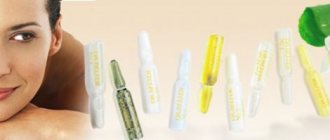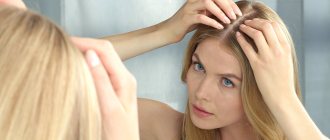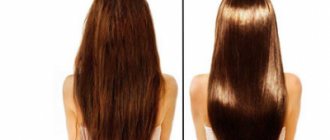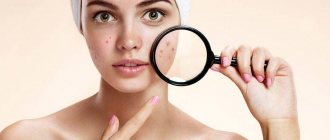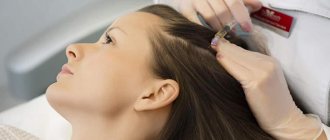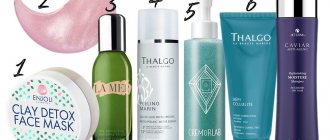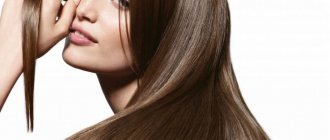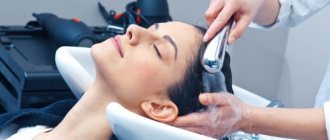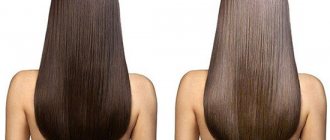If you don't already know what alopecia is, you're in luck. Alopecia is translated from Latin as “baldness”, “baldness”. Most men first encounter this problem at the age of 25-35. However, experts say that the disease is getting younger and is becoming more common among 18-25 year olds. But instead of looking for a good trichologist, many start looking for a good shampoo for hair loss and go to the doctor only when there is nothing left to save. In this article, we'll tell you why even the best hair loss remedies don't always work.
CAUSES OF HAIR LOSS
Before moving on to shampoos, you need to understand why hair falls out and what alopecia is. A person loses about 100 hairs per day. In autumn and winter, they fall out more intensely - the scalp is sensitive to temperature changes, and the hair needs additional care. However, if you notice that your hair has thinned significantly, it is better to consult a trichologist. This may be a sign of alopecia.
Alopecia is not always treatable. In some cases, there is nothing left but to select a therapy with which the disease will progress more slowly. There are three main types of alopecia: androgenetic, focal and diffuse.
ANDROGENETIC ALOPECIA
The most common type of alopecia. It occurs in approximately 75% of cases and is usually inherited. Androgenetic alopecia is associated with an increase in the level of dihydrotestosterone, which appears as a result of the breakdown of testosterone.
Dihydrotestosterone causes vasospasm. Blood does not flow to the hair follicles, the hair does not receive nutrition. At first they become weak and thin, then they stop growing and fall out. The process begins from the frontoparietal zone. The growth line gradually shifts back, while fairly thick hair remains on the temples and back of the head.
Actor Jude Law has the initial stage of androgenetic alopecia, which is absolutely normal for his age
The most effective way to combat androgenetic alopecia is hair transplantation. The second option is minoxidil. It dilates blood vessels and ensures blood flow. There are no shampoos with minoxidil; this product is produced in the form of a gel, foam or lotion. Before using minoxidil, you should consult your doctor, as it has contraindications and side effects.
LiveInternetLiveInternet
Quote from Disquiet
Read in full In your quotation book or community!
Life without sulfates or how I stopped hair loss.
This post will focus exclusively on the problem of hair loss, without touching on quality problems of the entire hair length. I will write about this separately. So here's my story. All my life I wanted long hair, but throughout my childhood I was cut quite short. I was able to grow hair that covered my shoulder blades only at graduation - in the 11th grade. Around this time, I began to notice that my hair was falling out catastrophically. Mom insisted that it was all about the length, that apparently it was genetically programmed for hair to grow to such a length. Haircut did not solve the problem at all. No matter how much I cut my hair, the hair in the bath did not decrease after washing. In general, it is worth noting that the hair came out precisely during washing, I was not lazy and counted them, because... There is a mesh in stock. With the norm being 100 (although now they say 50), my clump of 200-250 pieces shocked me. Despite the fact that I always made great efforts and used a huge number of folk remedies, none of this helped at all. They used nettle, kefir, egg, burdock oil, pepper tincture, and a bunch of different vitamins. Over the course of three years, a bald spot began to appear on one of the tops of my head, which, due to the fact that the hair was curly, was very visible.
The photo shows my head a year and a half ago. Then I started treatment with Alfaparf ampoules. Now a lot of new hair has grown, the situation is not so dire now, but I was able to stop the loss quite recently.
With all this, hair loss during the day and during styling was quite moderate. A trip to a trichologist also did not yield results. They tried to sell me some kind of their own line, they told me that the bulbs were weak and that I needed to step back more from the roots when applying the balm, and they also advised me to check the iron. I checked the iron level - it was absolutely normal (as were other parameters), and I always applied the balm only to the lower part of my hair. Since I also had problems with the length of my hair (extreme frizz, lack of shine), I began searching for good care. The first choice fell on Lash (surprisingly, it helped me)). I used Purest Green shampoo for a long time, and I noticed how my hair practically stopped falling out during these 9 months, then everything resumed. I only found out why several years later.
Further searches again could not improve the situation and severe hair loss. Since at that time I didn’t know that it was all about the shampoo and its effect on the scalp, I tried a bunch of products. I found several must-haves among them. True, they had no effect on the amount of hair leaving my head, but they contributed to the growth of new ones.
For me it was Active Hair Power Alfaparf
.
Within two weeks I had bangs of short hair, which had now reached the middle of the length of all my hair. I take a course out of the box every six months and try to regain the thickness lost over 7 years (the tail has become almost 2.5 times thinner). A lot of hair comes out, more than from the blue Optima ampoules. In addition, the skin responded to Optima with hives, which subsided an hour after use. Later, I read that ampoules promote swelling of the follicle, which is why the hair stays in them, but after discontinuation, all this splendor falls out))
I won’t write much
Utena The product was discontinued, but 5 cm per month made me incredibly happy. And now, in fact, the cause of hair loss and its solution.
Of course, there are a lot of them.
This includes stress, hormones, and a lack of certain substances in the body (for example, the already mentioned iron). In my case, it seemed like it was all about scalp sensitivity. I somehow didn’t pay attention, but all these years there were small ulcers periodically present on my head. I thought that this was a common thing, but sometimes all sorts of inflammations appear on the face. It turned out that all this is not just like that. I met one wonderful girl, whose story interested me very much... I had heard before that the basis of almost all shampoos is a rather aggressive surfactant - sodium laureth (or lauryl) sulfate
. But I would never have thought that it affects the scalp so much that they begin to fall out at such a wild speed and ulcers appear. I only believed this when she poured out Logona organic shampoo for me to try. It lasted me two weeks. Imagine my surprise when, after two washes, half as much hair fell out (instead of 150 pieces, about 70), and a week later I found 5 pieces in the drain. Since I didn’t find Logon, there were a couple more unsuccessful experiments (Styx and Aeto Barex), now I use Silky Vanilla shampoo from Organix and my hair does not fall out! I would never have thought that the solution to the problem is so simple - just read the ingredients and throw out options with aggressive surfactants. By the way, regarding the Purest Green. Instead of Laureth sulfate, the composition contained softer natural sodium cocosulfate, which a year later was replaced with Laureth (to reduce cost and simplify the preparation process), which is actually why it stopped helping me.
Now some information on the topic that I collected on the Internet.
So, sulfates began to be used in shampoos after the war, because...
it is a petrochemical product that has become much more affordable than natural soap bases. It is also added to washing powders and toothpastes (this is why you should not apply toothpaste to herpes and as a mask on the face, as some manage to do). Lauryl sulfate
is the cheapest surfactant, its derivative
laureth sulfate
is slightly softer, but in essence they are not much different.
Laureth-lauryl sulfates add foam to shampoo; it is due to it that such airy foam is obtained. If we talk about softer substitutes, the most common are: sulfosuccinates and sarcosinates are of plant origin, also acyl glutamates lauryl glucoside coco glucoside coco sulfate
- softer lauryl sulfate is made from coconut oil, but glucoside is still better.
ATTENTION: ADDING! Ammonium sulfate, which is found in some Lash shampoos, for example Rehabilitation, has an even worse effect on the scalp than laureth sulfate!!! Be careful! Shampoos containing the listed bases foam much worse and are washed off less well; therefore, the dirt may not all be washed out, you need to wash your hair more thoroughly. As far as I noticed, the hair does not slip because after regular shampoos and without conditioner, it is quite difficult to untangle the tangle that forms during the soaping process, but for me this is basically not a problem. To solve the problem with soaping, I do this: As many people know, it is better to wash your hair twice. The first time we wash off the dirt, the second time we let the shampoo substances act on the hair and skin and wash off the remaining dirt and shampoo residues. When you wash for the first time, you don’t need to dump half a can of shampoo on your head. You need to dilute it well with water and massage the non-foaming substance over the skin and hair, rinse. The second time, even a small amount of shampoo will wash out well, and then you need to wash your hair as usual and apply conditioner, carefully detangling your hair. I also learned that in Russia almost everywhere water is purified using sulfates, so water can play a role in hair loss, which is why you need to have a shampoo that is as soft as possible and does not aggravate the destructive effects of water, although ideally, of course, wash your hair with boiled or settled water.
Since it is quite difficult to look for sulfate-free shampoos, I will give examples of what I have already tried from different price categories.
The cheapest and by no means bad option is
Natura Siberica
for sensitive scalp.
In principle, all NS shampoos do not contain lauryl glucoside, the second cheapest surfactant, but less aggressive. I tried a shampoo for dry hair that didn’t really suit me (my hair quickly became greasy), but it’s a fact that it didn’t fall out. If you can’t buy something more expensive, then you can safely take it. In any case, it is better than shampoos with lauryl if you have a problem like me. Next, the option I have chosen now is the company Organix
.
I have Vanilla silk shampoo, it costs 300 rubles for 400 ml, it is sold for shower and soul (thanks to Sister of Mercy for the tip, it is wonderful!) The next option is Logona. costs about 400-500 rubles for 250 ml, I don’t know where to buy. I heard something about an online store at VDNKh only with pick-up, this is extremely inconvenient for me, so I refused this shampoo. Next, I tried Barex Aeto shampoo. Even though it does not contain sulfate, it did NOT HELP me with hair loss and dried out my hair. Pay attention to this. STYX also seems to be natural and contains lauryl! It made my hair stand out with double force. Alfaparf's volumizing and moisturizing shampoos from the Splendore Flori di lino series are sulfate-free, but they are not particularly suitable for me (for my oily scalp), so I no longer use them myself. Soon Alfaparf will also have a sulfate-free series for colored hair. A nice bonus of sulfate-free shampoos is that they do not wash out the dye from the hair cuticle. The next option is the German company Lavera
, I tried the orange volumizing shampoo, I’ll add a review later.
I don’t know the price, it’s sold at TsUM. My review is quite controversial; even though there are no sulfates, it is still aggressive for the scalp, but the hair after it is a treat. Options that I have heard about, but have not tried: Alterna Caviar Sexy Hair
In general, ALMOST all Ayurvedic and organic brands have shampoos with soft bases, look for it, choose.
You can also look for them among children's ones. Read the packaging. Let's say Weleda and Korres
, organic brands, are made with lauryl sulfate.
Also, Dikson Kation Valine shampoo did not cause hair loss for me. So, to summarize what has been said:
I described one of the causes of hair loss and the way to solve it. Nothing helped me until I understood what the problem was - an allergy to sulfates, even to the point of ulcers on the scalp. Since skin sensitivity to sulfates is quite common, try to solve your hair loss problem (if you have it) the way I did. In any case, there is nothing wrong with mild shampoos, but for colored hair there is generally only one benefit)
Next, I plan to experiment with sulfate-free face products.
DIFFUSE ALOPECIA
With diffuse or total alopecia, hair falls out evenly. This happens for various reasons - due to infectious and chronic diseases, hormonal imbalance, problems with the thyroid gland, oncology. Shampoo will not help if the cause of alopecia is not eliminated.
Diffuse alopecia can also be caused by poor diet, vitamin deficiency, stress, alcohol abuse and smoking. If these factors led to hair loss, most likely the shampoo will give results. But it is advisable to reconsider your lifestyle.
Is it normal if a lot of hair falls out when washing?
If you are worried about the rapid loss of hair follicles and are afraid of possible consequences in the future, count the amount of hair lost as carefully as possible.
How to determine whether hair comes out when washing your hair or not?
There is a good way - counting them.
Try this simple experiment: as soon as you wake up in the morning, look at your pillow to see if there are any hairs left there. Then take a clean comb and start combing your hair. After this, count the rods stuck in the teeth of the comb. Before going to bed, loosen your hair and comb it again. As a result, the number of fallen curls should be approximately 100-120 pieces. If there are a lot of them, you should take the necessary measures.
If you don't have time to count your curls every day, bring another quick test. To do this, do not wash your hair for only 3 days, then squeeze the hair on the top of your head into a bun and pull it through your fist. Then look at how many rods are left in your palm. Up to 5 is considered the norm; if more, then urgent measures should be taken.
Why does my hair start to fall out a lot after washing my hair?
The causes of this problem can be divided into internal and external.
Internal ones include:
- diseases of internal organs - diseases of the endocrine system, diseases of the gastrointestinal tract, for example, gall bladder, liver, kidneys, skin diseases;
- stress or nervous tension;
- hormonal changes - pregnancy, thyroid disease, menopause;
- infectious diseases;
- decreased hemoglobin;
- intoxication of the body;
- external causes - exposure to ultraviolet rays, improper care and nutrition, drinking alcohol and smoking, dyeing, perm.
Normally, each rod is covered with a special film, which gives it protection from external influences. Saturated fatty acids, UV rays, oils, fragrances that are part of cosmetics damage this film and cause hair loss. The situation is aggravated by constant temperature changes. That's why proper care is so important for your curls.
How to deal with severe hair loss after washing your hair?
Unfortunately, baldness has long ceased to be a problem for older people.
Very often, hair loss can occur in young people, including teenagers. The problem is not just an aesthetic one - sparse strands not only harm the image, but also indicate various diseases.
Having found out why hair falls out when washing your hair, you can begin to take measures to combat the defect. First of all, if you find a lot of hair in the sink after washing your hair, don't panic.
To reduce the intensity of their loss, follow these rules:
- before washing, comb thoroughly with a massage comb, this way you will accelerate blood circulation in the skin and activate the process of exfoliation of dead cells;
- Lather your curls with shampoo only once, if the locks are very dirty - 2 times, but no more;
- rinse your hair with slightly cool water;
- choose a balm that contains phytoestrogens;
- when you wrap your head with a towel, choose a thin material so that it does not pull on your curls;
- Comb the washed curls with a plastic comb with sparse teeth and only after they are completely dry.
It is known that hot water cannot be used for washing, as it burns the skin. It’s also better not to use cold ones. The optimal temperature is 35-37 degrees.
What to do if severe hair loss occurs when washing your hair?
If the curls actually fall out in large quantities, then use the following recipes to eliminate this problem. Regularly cleanse your curls of excess dirt.
Since frequent washing can be the main cause of hair loss, perform bath procedures every 2-3 days. Also comb your strands regularly and give a light head massage. Make compresses and masks once a week. They will help the strands recover and strengthen, and after a month you will also notice that hair loss has noticeably decreased. Use common mask recipes to strengthen the rods.
If you notice that the problem of hair loss when washing your hair does not disappear after the efforts made, consult a doctor. He will help determine the exact cause of the hair loss and select the right treatment for you.
HOW TO CHOOSE SHAMPOO
First of all, before buying shampoo, you need to consult a trichologist. He will determine what is causing your hair loss and prescribe the necessary examinations.
The most effective shampoos against baldness are pharmacy brand shampoos. Brands that produce medicinal cosmetics conduct a series of clinical trials to prove the effectiveness and safety of the product, and only after that it hits the shelves. Even professional brands of hair care products do not guarantee results for alopecia. And 2 in 1 products, which the mass market loves so much, especially cannot serve as a shampoo, conditioner and at the same time fight hair loss. We have selected 5 shampoos for hair loss from pharmacies and more.
Vichy Dercos Aminexil
There is no need to introduce the Vichy brand - it is a well-known brand of pharmaceutical cosmetics. Dercos Aminexil shampoo is suitable for both men and women. According to the manufacturer, this product is suitable for allergy sufferers, reduces the rate of hair loss and promotes the growth of new hair. Aminexil works on approximately the same principle as minoxidil - it improves blood circulation. For greater effect, experts advise using shampoo in combination with other products, for example, along with ampoules against hair loss.
Ducray Anaphase+
Anaphase+ shampoo enhances microcirculation of the scalp and is suitable for preparing for the application of external anti-hair loss products. The manufacturer warns that this shampoo complements other treatments for alopecia and will not help if used alone. But Ducray promises a reduction in hair loss in the autumn-winter period when using Anaphase+.
Dr. ForHair Folligen
Not the most common product, which is mainly sold on the Internet. According to customers, this shampoo can dry out hair. It contains biotin, zinc compounds and niacinamide. The latter substance was previously used in facial cosmetics, but now it is increasingly used in the manufacture of shampoos. Niacinamide slows down hair aging, prevents hair loss and “awakens” dormant hair follicles.
Tricomin
This is one of the most expensive shampoos for hair loss. Its composition is aimed at restoring the structure of hair follicles damaged by excess dihydrotestosterone, so Tricomin is suitable for men with androgenetic alopecia.
Wella Professional
Wella's line of professional skincare cosmetics includes a product that is positioned as an anti-hair loss shampoo for men. But the description of the product says that it is intended for weakened hair, and not to combat alopecia.
Prevention
To protect yourself from hair loss when dyeing your hair, it is important to give your head the necessary care:
- nourish your skin and strands with natural masks against hair loss a couple of times a week;
- rinse after each coloring with herbal infusions;
- comb your hair 3-4 times a day (be sure to go to bed);
- massage your scalp with oils.
To get rid of foreign odor in your hair, rinse your hair with water and a few drops of lemon.
Give your hair some care. And your hair will always be luxurious.
- Strengthen your roots. This will prevent further hair loss. Use egg yolks instead of your regular shampoo every week. Take two yolks, add warm (not hot) water. Stir. Wet strands and apply product to skin and hair. Rub into the dermis. Leave for half an hour. Rinse off with warm water.
- Stimulate the growth of new strands. Take 1 yolk for every 10 cm of hair length. Add a few drops of lemon juice. Rub into strands and skin. After 10 minutes, rinse with warm water. Use 2-3 times a week.
Use oil. Apply to roots and curls. Give yourself a light massage. Leave it overnight and wash it off with shampoo in the morning. This mask will strengthen your hair, improve blood circulation in your head, and saturate your skin with vitamins.
Take care of your hair after coloring. Take 1 tbsp. chamomile, yarrow, sage, celandine. Pour 1 liter of boiling water. Keep for 30 minutes. Strain. Rinse after shampoo or when you wash off the color.
Restore hair structure. Pour boiling water over the rye bread pulp. Leave for a couple of hours (3-6). Strain. Rub the paste into the skin. Apply to strands from the roots and along the entire length. This has a beneficial effect on hair growth and restores its structure.
Restore blood circulation. Mix ¼ hot pepper with 50 ml of alcohol. Grind the pepper. Fill with alcohol. Leave it for a week. Strain. Before use, add 10 parts of water to 1 part hot pepper tincture. Rub the solution into the skin. apply 2 times a week.
Trim the ends. It is important to prevent the appearance of split ends in time. Visit your hairdresser every month.
Protect the ends. Apply vegetable oils to the ends of the strands 2 times a week.
Garlic and onion juice have a beneficial effect on the condition of the skin and curls.
How often can you dye your hair and how to restore it after that, watch the video:
Prevention of hair loss consists of following these rules:
- no need to lighten your hair two or more shades;
- more than 15 days must pass between chemical procedures;
- use special store products;
- do not use a hairdryer, curling iron, or straightener unless absolutely necessary (and if you use this technique, apply heat-protective agents);
- apply balm;
- comb your hair before going to bed;
- do not comb wet hair (and do it correctly: start from the ends, moving towards the roots);
If your hair is damaged, try several methods to improve the condition of your skin and strands.
Use homemade masks, visit a cosmetologist, do self-massage, take proper care of your hair, and choose your dye carefully.
Don't want to give up coloring? Then you need to provide your strands with comprehensive care.
And your hair will thank you with health, radiance, tenderness and beauty.
